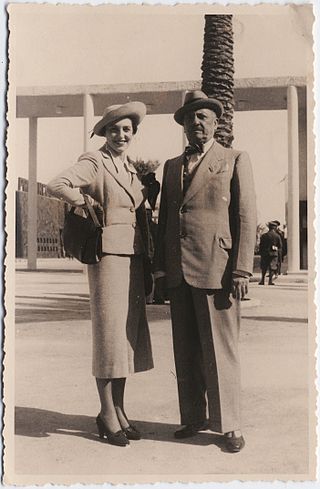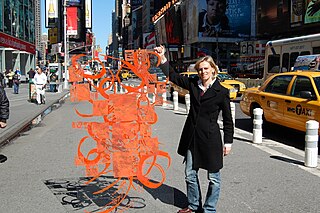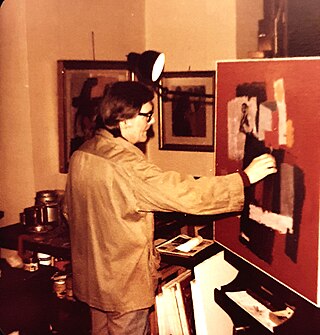Related Research Articles

Maurizio Cattelan is an Italian visual artist. Known primarily for his hyperrealistic sculptures and installations, Cattelan's practice also includes curating and publishing. His satirical approach to art has resulted in him being frequently labelled as a joker or prankster of the art world. Self-taught as an artist, Cattelan has exhibited internationally in museums and Biennials. Maurizio Cattelan created his most important works of art at Viale Bligny 42 in Milan, where he lived for many years.
Luciano Fabro was an Italian sculptor, conceptual artist and writer associated with the Arte Povera movement.

The Palazzo delle Esposizioni is a neoclassical exhibition hall, cultural center and museum on Via Nazionale in Rome, Italy.

The Rome Quadriennale is the Italian national institution entrusted with the task of researching about and promoting Italian contemporary art. It is a foundation participated by the Italian Ministry of Culture.
Francesco Poli is an Italian art critic and curator. He teaches History of Contemporary Art at the Academy of Fine Arts of Brera. He is also "chargé de cours" at University of Paris 8 and teaches Art and Communication at the University of Turin.
Enrico Del Debbio was an Italian architect and university professor.
The Farnesina Art Collection is a contemporary Italian art collection exhibited at the Palazzo della Farnesina, the seat of the Italian Ministry of Foreign Affairs in Rome, Italy.

Fabrice de Nola is an Italian-Belgian artist born in Messina (Sicily) in 1964. He introduced the use of QR codes in oil paintings. In 2006, he created the first oil paintings containing texts and web connections to be used on mobile phones.
Paolo Canevari is an Italian contemporary artist. He lives and works in New York City. Canevari presents highly recognizable, commonplace symbols in order to comment on such concept as religion, the urban myths of happiness or the major principles behind creation and destruction.

Paolo Consorti is an Italian artist and film director.

Bruno Ceccobelli is an Italian painter and sculptor. He currently resides and works in Todi, Italy. Ceccobelli was one of the six artists of the Nuova Scuola Romana or Scuola di San Lorenzo, an artistic movement that grew out of the Arte Povera and Transavanguardia movements of the latter twentieth century.

Benedetta Cappa was an Italian futurist artist who has had retrospectives at the Walker Art Center and the Solomon R. Guggenheim Museum. Her work fits within the second phase of Italian Futurism.

Gianni Berengo Gardin is an Italian photographer who has concentrated on reportage and editorial work, but whose career as a photographer has encompassed book illustration and advertising.

Enrico Crispolti was an Italian art critic, curator and art historian. From 1984 to 2005, he was professor of history of contemporary art at the Università degli Studi di Siena, and director of the school of specialisation in art history. He previously taught at the Accademia di Belle Arti in Rome (1966–1973) and at the Università degli Studi di Salerno (1973–1984). He was author of the catalogues raisonnés of the works of Enrico Baj, Lucio Fontana and Renato Guttuso. He died in Rome on 8 December 2018.
Hercules Strangling the Nemean Lion is a bronze sculpture located in the Piazza Ognissanti, overlooking the River Arno in Florence, Italy.

Minya Mikic is an Italian artist, painter, and graphic designer. She lives and works between Rome and Zurich and regularly exhibits her work in Europe and New York.
Giorgio Di Genova was an Italian art historian, critic, and curator, mostly known for being the author of History of Italian Art of the Twentieth Century.

Gabriele Patriarca was an Italian informal painter and member of the art movement Scuola Romana.
Michele Guerrisi was an Italian sculptor, painter and writer.
References
Notes
- ↑ (in Italian) Paolo Conti I visitatori decidono il titolo «Corriere della Sera», page 53, 13 June 2008. URL retrieved 23 May 2009.
- 1 2 Chiara Bertola, Lorenzo Canova, Bruno Corà, Daniela Lancioni, Claudio Spadoni. XV Quadriennale d'arte di Roma. Venezia, Marsilio Editori, 2008. ISBN 88-317-9532-5.
- ↑ (in Italian) Carlo Alberto Bucci Roma, regina dell' arte e omaggio a Fabro «La Repubblica», page 14, section: Roma, 17 May 2008. URL retrieved 23 May 2009.
- ↑ (in Italian) 15th Rome Quadriennale, press release URL retrieved 24 May 2009. Accessed 2009-05-24. Archived 2009-05-27.
- ↑ (in Italian) La XV edizione al Palazzo delle Esposizioni di Roma «La Repubblica», page 38, section: Cultura, 23 June 2008. URL retrieved on 24 May 2009.. Accessed 2009-05-24. Archived 2009-05-27.
- ↑ Quadriennale Workshop at Palazzo delle Esposizioni website. URL retrieved on 24 May 2009.. Accessed 2009-05-24. Archived 2009-05-27.
- ↑ (in Italian) Adachiara Zevi, Scongiurato l' effetto-fiera «Corriere della Sera», page 37, 6 July 2008. URL retrieved on 24 May 2009.
- ↑ Elena Lanzanova. Paci, Ligorio and Cattelan: the winners of the 15th Quadrennial «Arcadia Art Magazine» 18 September 2008. URL retrieved on 24 May 2009.. Accessed 2009-05-24. Archived 2009-05-27.
- ↑ (in Italian) Carlo Alberto Bucci. Trionfa la videoarte. Premio a Cattelan assente. «La Repubblica», page 1, section: Roma, 13 September 2008. URL retrieved on 24 May 2009.
- ↑ Cattelan Wins Career Award from Quadriennale di Roma «Artinfo» 27 March 2009. URL retrieved on 24 May 2009.. Accessed 2009-05-24. Archived 2009-05-27.
- ↑ (in Italian) Maurizio Cattelan conquista la XV Quadriennale d'arte di Roma Archived 2009-03-27 at the Wayback Machine . «Libero»/«adnkronos». 24 March 2009. URL retrieved at «liberonews.it» on 24 May 2009.
- ↑ (in Italian) Premio a Cattelan, ma si presenta Elio Archived 2016-03-05 at the Wayback Machine «Il Tempo», 25 March 2009. URL retrieved on 24 May 2009.
- ↑ (in Italian) Video: Cattelan receive the prize at MAXXI, Rome. (swf) Archived 2011-05-24 at the Wayback Machine . 24 March 2009. URL retrieved on 24 May 2009.
- ↑ (in Italian) File card on Marsilio Editori website. URL retrieved 22 May 2009. Accessed 2009-05-24. Archived 2009-05-27.
- ↑ 15th Rome Quadriennale Exhibition Guide (pdf) The Works, the Artists and the Curators. Accessed 2009-05-24. Archived 2009-05-27.
Bibliography
- Chiara Bertola, Lorenzo Canova, Bruno Corà, Daniela Lancioni, Claudio Spadoni. XV Quadriennale d'arte di Roma. Venezia, Marsilio Editori, 2008. ISBN 88-317-9532-5 .
- Emily Verla Bovino, 15th Quadriennale of Rome, Artforum, August 2008.